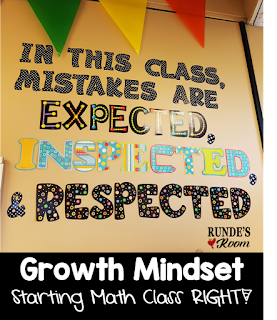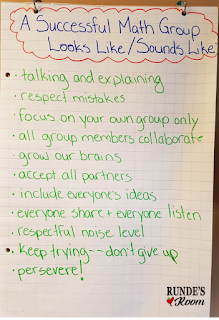My students love task cards - especially ones that get them moving. That's exactly why I created my Math Circles - sets of task cards that get my students up and moving while learning and mastering the concepts. So engaging for all students and absolutely perfect for your kinesthetic learners. If you're anything like me, you have probably have tons of sets of task cards in your teacher stash already. One day last year, while I was figuring out ways to use my task cards in more engaging ways, I had an awesome thought. I wanted a GIANT game board so we could "play math" in a GIANT way. So, I made it my plan to accomplish this during the summer. I'm so glad I did - our giant game board has been an amazing addition to our math classes, and whenever my students literally BEG me to "play math", I know I've got a winner.
Make the Game Board
I ordered my game board through Vistaprint. It is a 4 x 8 vinyl banner. If you create an account with Vistaprint, they have some amazing sales and promo codes they will keep you informed about. I waited until they had a good sale going to buy the banner. I bought some board game clip art from Zip-a-Dee-Doo-Dah Designs and resized the game board a bit in photoshop (powerpoint would work, too) so it would fit. I resized it to 24 x 48 inches and when I uploaded it in Vistaprint, the image worked perfectly - it's nice and crisp and fills the banner perfectly.
Now, go big or go home doesn't apply here. You don't have to make a giant banner - anything would work. You could draw a game board on bulletin board paper (it would make an awesome permanent bulletin board if you pinned the game pieces on it - a bulletin board you don't have to worry about changing ALL year long). You could also use a large piece of cardboard - get your students involved in drawing the actual game board! You could also do this on a smaller scale on regular paper so you could use it as a math station. Anything goes!
Last year when I thought of this idea, I tried it out by projecting an image of a game board on my whiteboard (there are tons of free blank game boards available when you search on google images). We just used whiteboard markers to track our progress around the board. Quick and easy and best of all - no prep.
To go along with our GIANT game board, I decided we just had to have some GIANT dice, so I found some on Amazon (I have included my affiliate link below this post). You can use almost anything for the game pieces - I have a fun little collection of "ugly dolls" (they are just too cute to be ugly) in my classroom that work perfectly.
 I used my Place Value Math Circle to break in our new game board (but could use any set of task cards - and this doesn't just have to be limited to math). We rolled out our board game in a nice open area and I divided the class into two teams. I had previously printed out the numbers for the game (the same set of numbers can be used with many of my math circles) and have made them into necklaces with string and a clip. These hang on a hook in my classroom and we use them often.
I used my Place Value Math Circle to break in our new game board (but could use any set of task cards - and this doesn't just have to be limited to math). We rolled out our board game in a nice open area and I divided the class into two teams. I had previously printed out the numbers for the game (the same set of numbers can be used with many of my math circles) and have made them into necklaces with string and a clip. These hang on a hook in my classroom and we use them often.
 And that's it. SO much fun. When we were finished, we came back to the classroom to reflect on our activity. I posted a question from my Math Reflection Fans and asked them to answer the question on a sticky note which we then posted. You could also just have them write their answers on a large piece of chart paper (whole group graffiti style) or on the whiteboard.
And that's it. SO much fun. When we were finished, we came back to the classroom to reflect on our activity. I posted a question from my Math Reflection Fans and asked them to answer the question on a sticky note which we then posted. You could also just have them write their answers on a large piece of chart paper (whole group graffiti style) or on the whiteboard.
3
Make the Game Board
I ordered my game board through Vistaprint. It is a 4 x 8 vinyl banner. If you create an account with Vistaprint, they have some amazing sales and promo codes they will keep you informed about. I waited until they had a good sale going to buy the banner. I bought some board game clip art from Zip-a-Dee-Doo-Dah Designs and resized the game board a bit in photoshop (powerpoint would work, too) so it would fit. I resized it to 24 x 48 inches and when I uploaded it in Vistaprint, the image worked perfectly - it's nice and crisp and fills the banner perfectly.
Now, go big or go home doesn't apply here. You don't have to make a giant banner - anything would work. You could draw a game board on bulletin board paper (it would make an awesome permanent bulletin board if you pinned the game pieces on it - a bulletin board you don't have to worry about changing ALL year long). You could also use a large piece of cardboard - get your students involved in drawing the actual game board! You could also do this on a smaller scale on regular paper so you could use it as a math station. Anything goes!
Last year when I thought of this idea, I tried it out by projecting an image of a game board on my whiteboard (there are tons of free blank game boards available when you search on google images). We just used whiteboard markers to track our progress around the board. Quick and easy and best of all - no prep.
To go along with our GIANT game board, I decided we just had to have some GIANT dice, so I found some on Amazon (I have included my affiliate link below this post). You can use almost anything for the game pieces - I have a fun little collection of "ugly dolls" (they are just too cute to be ugly) in my classroom that work perfectly.
Play the Game
 I used my Place Value Math Circle to break in our new game board (but could use any set of task cards - and this doesn't just have to be limited to math). We rolled out our board game in a nice open area and I divided the class into two teams. I had previously printed out the numbers for the game (the same set of numbers can be used with many of my math circles) and have made them into necklaces with string and a clip. These hang on a hook in my classroom and we use them often.
I used my Place Value Math Circle to break in our new game board (but could use any set of task cards - and this doesn't just have to be limited to math). We rolled out our board game in a nice open area and I divided the class into two teams. I had previously printed out the numbers for the game (the same set of numbers can be used with many of my math circles) and have made them into necklaces with string and a clip. These hang on a hook in my classroom and we use them often.
I handed the first team the first card from the math circle. They had to read the instructions and arrange themselves into the number on the card (numbers are written in different ways on different cards - in word form, expanded form, by place value column, and greater than and less than form). When they were finished, the opposite team examined the card and determined whether the number the first team made was correct or incorrect. If correct, the first team got to roll the dice and move the number of spots indicated. If they were incorrect, they did not get to roll the dice or move. Then, the second team got the next card in the math circle - and followed the same procedure. Repeat. If you are using 2 dice, the game goes quite quickly - if you want to make the game last longer, only roll one.
In the picture above, students were asked to build a number that was 1000 greater than 6,588,301. I also have sets that fit both the US and Canadian way of writing the numbers (either with commas as place value holders, or spaces).
 And that's it. SO much fun. When we were finished, we came back to the classroom to reflect on our activity. I posted a question from my Math Reflection Fans and asked them to answer the question on a sticky note which we then posted. You could also just have them write their answers on a large piece of chart paper (whole group graffiti style) or on the whiteboard.
And that's it. SO much fun. When we were finished, we came back to the classroom to reflect on our activity. I posted a question from my Math Reflection Fans and asked them to answer the question on a sticky note which we then posted. You could also just have them write their answers on a large piece of chart paper (whole group graffiti style) or on the whiteboard.
My students are already asking when we're using the game board again ... and I have to admit, I can't wait!!! I've got a Rounding Math Circle that will be perfect for the end of the week!



































